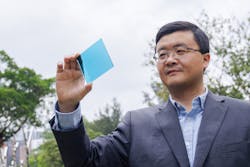Organic solar cells reach record 19% efficiency
A team from Hong Kong Polytechnic University (PolyU) in China achieved 19.31% efficiency in binary organic solar cells (OSCs; see figure and video). It’s the highest power-conversion proficiency generated from solar irradiation yet achieved for such cells, according to research team co-leader Gang Li, a professor of renewable energy and energy conversion technology in the Department of Electronic and Information Engineering at PolyU, and associate director of the school’s Research Institute for Smart Energy.
Also known as polymer solar cells, OSCs are the backbone of photovoltaics (solar panels), generating electricity from sunlight. They consist of a mix of electron donor (a reducing chemical agent that becomes oxidized and donates electrons to another compound) and acceptor (an oxidizing agent that becomes reduced and accepts electrons transferred to it from another compound) materials in the photoactive layer. Classical binary OSC film comprises bulk heterojunction of these donor and acceptor materials, a structure necessary to achieve high power conversion efficiencies in OSCs.
Power and control
Like bulk heterojunction, control of an OSC’s morphology (the arrangements of microstructures and how they perform in the cell’s photo-active film layer) is also necessary. This is a core challenge in OSC technology, but Li’s team has begun to address it with the development of a morphology-regulating technique involving 1,3,5-trichlorobenzene (TCB), a manmade chemical compound used as a dielectric fluid to regulate crystallization.
This new mechanism of nonmonotonic intermediate state manipulation allows the team to control the bulk heterojunction morphology in an OSC, while at the same time optimize the crystallization dynamics and energy loss common in nonfullerene cells.
“The conventional additive approach is good at boosting bulk heterojunction morphology crystallization,” Li says. Yet this prompts excessive molecular aggregation, which lowers the photovoltage (a.k.a. open circuit voltage, or Voc) of OSCs. It also introduces unnecessary nonradiative recombination, which lowers the light generation efficiency and increases heat loss in the cell.
“The new method in our work realized a magical nonmonotonic intermediate state transition in the film formation process in the OSC, in which the aggregation/crystallization of the organic acceptor material is enhanced in the main solvent removal process,” Li says. “Then, in the TCB removal process, a relaxation of crystallization occurs. This leads to optimized bulk heterojunction morphology with reduced nonradiative recombination and higher Voc and solar cell efficiency.”
Solar powering the future
OSCs have distinct advantages over existing solar cell systems—they’re more flexible, lightweight, transparent, and have colorful form factors, all of which are promising for expanding solar application scenarios, according to Li, who has been on a years-long journey to optimize this emerging solar technology.
His team’s developments narrow the current efficiency gap with existing solar technologies on the market.
“The adoption of new solar technology is crucial for future applications,” Li says. While the 19.31% power-efficiency and conversion breakthrough already pave the way for significant advancements in solar cell efficiency, as well as applications including building-integrated solar cell systems and portable electronics, the team’s work continues.
“We’re working to overcome this nearly 20% OSC efficiency now, and we’re almost there,” Li says.
About the Author
Justine Murphy
Multimedia Director, Digital Infrastructure
Justine Murphy is the multimedia director for Endeavor Business Media's Digital Infrastructure Group. She is a multiple award-winning writer and editor with more 20 years of experience in newspaper publishing as well as public relations, marketing, and communications. For nearly 10 years, she has covered all facets of the optics and photonics industry as an editor, writer, web news anchor, and podcast host for an internationally reaching magazine publishing company. Her work has earned accolades from the New England Press Association as well as the SIIA/Jesse H. Neal Awards. She received a B.A. from the Massachusetts College of Liberal Arts.

